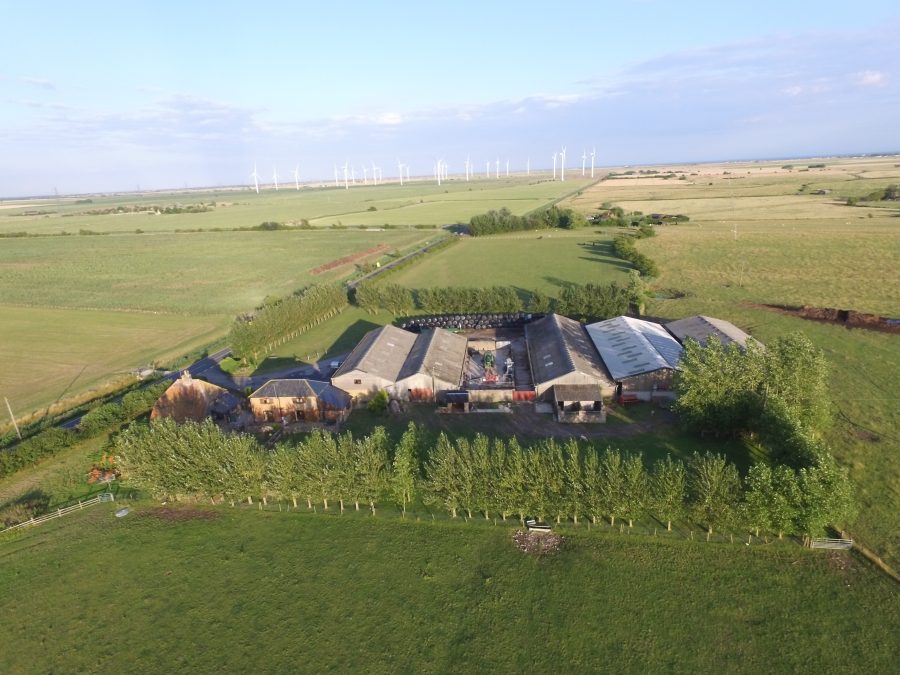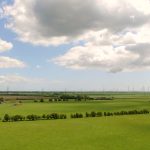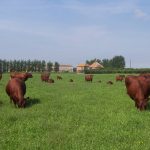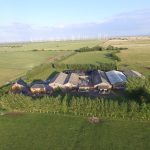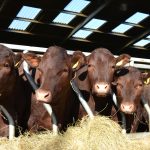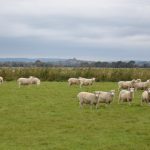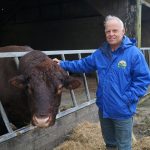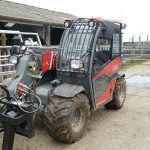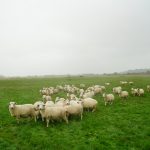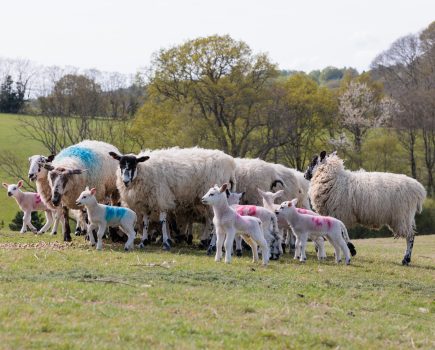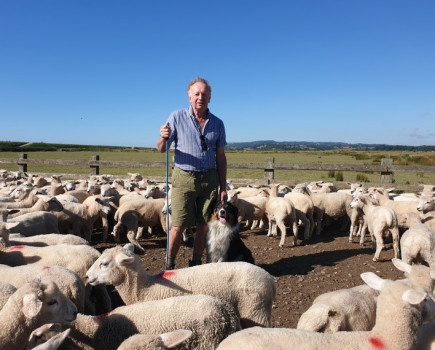This month Nigel Akehurst visits Lamb Farm, on the edge of Romney Marsh in the village of East Guldeford, near Rye, East Sussex, to meet Simon Wright and learn more about his mixed farming enterprise, Wright Farm Partnership, which encompasses beef, sheep, and arable operations.
Leaving the historic town of Rye, I followed the A259 as it stretched across the flat, treeless expanse of Romney Marsh. In the distance a line of wind turbines spun quietly, their tall silhouettes marking the landscape. Soon I saw the sign for Lamb Farm, tucked just off the main road, and turned into the gravel-lined yard. Ahead of me was a charming farmhouse and 18th-century wool shed, now converted into two cosy cottages, a glimpse into the farm’s rich past.
Inheritance tax changes and impact on farmers
Spotting Simon through the kitchen window, I waved and he beckoned me inside. Over a cup of coffee, we began discussing the hot topic of the moment: the proposed inheritance tax reforms to agricultural property relief (APR) and business property relief (BPR), now commonly referred to as the “tractor tax”.
I asked Simon for his initial reaction to the budget announcement.
“We half-expected it,” he said. “There had been a lot of rumours leading up to the announcement suggesting they might go back on their word and target family farms.”
As a relatively small landowner himself, with just 130 acres, Simon didn’t believe he would be directly impacted but expressed concern for many of his landlords who could be forced to sell land to meet their tax liabilities. This, he feared, could undermine the viability of his business, which relies heavily on rented land.
Simon pointed to a recent analysis by the NFU, which highlighted the fact that new tax measures could affect 66% of estates, including many small to medium-sized farmers. He argued that this showed Labour had misjudged the situation, with their figures and reasoning “completely wrong”.
“The new tax doesn’t just hit farmers,” Simon added. “It targets family businesses across the board, as well as the many auxiliary businesses that rely on agriculture.”
He was heartened by the Conservatives’ and Reform‘s pledges to reverse the changes if they win the next election and noted the growing public support for an upcoming farmers’ protest in London.
At the time of our conversation, DEFRA had suggested softening the changes for farmers, possibly by exempting older farmers, but the Treasury had dismissed these efforts, insisting that the reforms were “fair and balanced”.
Moving to Romney Marsh
The conversation shifted to Simon’s farming career and the story of Wright Farm Partnership. Originally from the rolling hills of Exmoor, Simon spent a year at Bicton Agricultural College before working for ICI on their dairy farm in Somerset for five years, until the company sold the farm.
At 25, Simon and his late wife Anne made the bold move to Romney Marsh in 1992, with their entire life packed into an old Ford Fiesta.
“It was quite a shock,” he remarked, recalling the stark contrast of the flat, dry, treeless landscape. However, what initially seemed like a challenge soon proved to be a smart business decision. Simon began by managing Lamb Farm for five years before being offered the chance to rent 351 acres on a five-year farm business tenancy (FBT).
He noted that in those days, banks were more willing to lend, but the real challenge came when they had to secure enough quota for the sheep and cattle. “We finally achieved that, only for the Government to abolish the quota system, rendering our substantial investment worthless,” he explained.
Over the years, Simon and Anne weathered many storms, including the foot and mouth disease outbreaks of 2001 and 2007 and the first case of bluetongue in 2010, all of which caused significant losses for farmers in the area. Despite these setbacks, Simon’s resilience helped them push through.
Building Wright Farm Partnership
Today, Simon’s farming enterprise includes a beef suckler herd of 80 Pedigree Sussex cows along with followers, a flock of 1,000 pure Romney ewes and a modest acreage of arable land.
Reflecting on his business growth over the years, Simon credits a combination of hard work and good fortune, particularly in being able to take on neighbouring land as local farmers retired without successors. He also expressed gratitude to his landlords, describing them as genuine farmers who have been fair and reasonable with rent levels.
By 2018, Simon was farming 650 acres, and that year he expanded further, adding 500 acres through a share farming agreement. This allowed him to increase his flock to 1,500 ewes and his herd to 400 cattle. Around this time, his son George returned from Dorset to join the family business, a decision that became especially meaningful as it was just before Simon’s wife, Anne, sadly lost her battle with cancer.
Simon relinquished his share farming agreement to allow George to establish himself independently by taking over that farm and its livestock under his own FBT. With a wry smile, Simon noted that much of his machinery seems to spend more time on George’s farm than his own.
Farming and conservation
Simon explained that a portion of the main farm was designated as a Site of Special Scientific Interest (SSSI), an area crucial for overwintering wader feeding grounds and supporting rich ditch ecosystems.
As a result, most of his permanent pasture is enrolled in higher-level stewardship agri-environment schemes, which provides strong financial support, helping to cover rent and encouraging sustainable land management.
An active member of three local farm cluster groups, Simon has a strong commitment to preserving and enhancing wildlife on Romney Marsh. He has implemented several conservation initiatives, such as planting bee-friendly wildflower mixes, establishing sunflower plots for pollinators and creating habitats to support native species. These efforts reflect his dedication to farming in harmony with nature and helping to maintain the area’s unique biodiversity.
Challenges of modern farming
As we walked through the farm, Simon proudly showed me one of his two Sussex bulls, an impressive beast, along with a group of cows and calves recently brought in for weaning. The animals looked immaculate, a testament to Simon’s dedication as a skilled stockman.
“Farming isn’t just a job; it’s a vocation. You’ve got to love what you do,” he remarked.
The farmyard itself was modern and tidy, equipped with a nearly new telehandler, evidence of the years Simon has invested into building up his operation.
When I asked if he preferred the sheep or cattle side of the business, he admitted that while the cows required more initial outlay, he gets more enjoyment from working with them now that he has all the necessary equipment. Still, both sheep and cattle play vital roles in keeping the farm profitable.
Simon keeps labour costs low by using a simple system, with low-input native breeds. Apart from shearing and hiring a local contractor for baling, combining and spraying, he doesn’t employ any outside labour.
His livestock is 100% grass-fed, which not only saves on expensive concentrates but also reduces his overall time investment. Thanks to the farm’s dry, free-draining pastures, Simon can keep his cattle outdoors until January, bringing them in only for three or four months.
In March, his 80 Sussex cows calve, and most of them manage without assistance. By the end of March or early April, they’re ready to go back out just as lambing season starts. Through selective culling, Simon has reached a point where he now only needs to assist less than 2% of his 1,000 ewes during outdoor lambing, achieving an average lambing scan percentage of 1.5.
Simon handles most of the fieldwork himself, using his own kit, and produces around 250 acres of hay and 50 acres of haylage, as well as doing any necessary cultivation for his small arable acreage.
Despite these efforts to control costs, he notes that machinery prices have soared. A recent tractor quotation came in at £110,000, a staggering increase compared to the £25,000 he paid for a similar spec machine 25 years ago.
Even with recent improvements in cattle and sheep prices, he admits it’s challenging for most livestock farmers to justify such expenses. “And with proposed changes to APR and BPR on the horizon, it’s no surprise that farmers are holding off on new purchases and preparing for tough times ahead,” he added.
Marketing and Red Tractor
Simon sells most of his Sussex heifers privately for breeding, primarily to farms in the South East, many of whom are incentivised by the native breeds at risk Sustainable Farming Incentive supplement at £167/Ha.
While he sends a few store cattle through Ashford Market, he prefers to fatten as many of his steers on grass as possible, reaching a finished weight at around 26 to 30 months. His steers average a deadweight of 350kg, and he supplies a number of local butchers, including Andy Clarke at Park Farm Butchers in Hawkhurst, who buys from him regularly.
Simon was disappointed when Tottingworth closed, as he had established a solid business selling beef boxes directly to customers and supplying whole sheep carcasses to several restaurants in Rye. However, like many local farmers, he found the journey to West Sussex impractical and decided to stop that line of business.
Simon sells most of his female lambs for breeding, often in large lots to farms looking to build up their flocks. Nearly all the wether lambs are sold as store lambs through Ashford.
On the arable side, Simon grows a small acreage of crops on Romney Marsh, and with grade one and two land, his fields yield well.
“If you don’t do four tonnes an acre, you’re probably doing something wrong,” he remarked.
Simon sells his crops to the highest bidder, though he is notably not Red Tractor assured. He strongly dislikes the assurance scheme, even to the point of refusing to buy any Red Tractor products at the shops.
Plans for the future
Looking ahead, Simon hopes that once the budget uncertainties settle, he will be able to continue expanding his farm.
“I’ve always been proactive; taking on more grazing land is the easy part,” he explained.
“But we can’t compete with the arable farmers around here. They can pay twice the rent we could ever afford. There’s no point working yourself into the ground for nothing; you have to make something out of it.”
As for retirement, he has no plans to step back any time soon.
“My elderly parents are still farming on Exmoor,” he added with a smile. “It’s what keeps you getting up in the morning.”
Farm facts
- 650 acres of permanent pasture and arable crops made up of rented ground on various tenancy and grazing agreements which includes 130 acres of owned land (with much of the land in higher level stewardship and other agri-environment schemes)
- 80 Pedigree Sussex suckler cows (spring calving indoor in March)
- 1,000 pure Romney ewes (outdoor lambing in April)
- Makes hay on 250 acres and haylage on 50 acres
- Member of three local farm cluster groups
- Muck for straw deal with neighbour Philip Merricks
- Stopped selling beef boxes and supplying restaurants after close of Tottingworth
- Simon Wright
Photos: ©Nigel Akehurst
For more like this, sign up for the FREE South East Farmer e-newsletter here and receive all the latest farming news, reviews and insight straight to your inbox.

